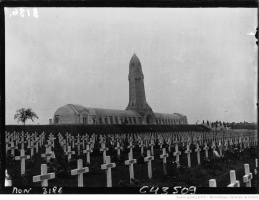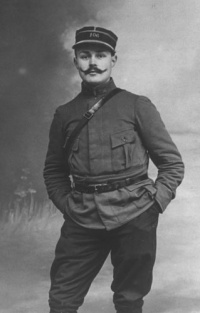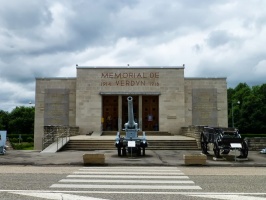Creation of the Memorial↑
The Comité national du souvenir de Verdun (National Committee for the Remembrance of Verdun) (CNSV) was founded in 1951 by Maurice Genevoix (1890-1980)]], a writer whose book, Ceux de 14 (Those of 14), remains the most authentic account of the battle of Verdun. In 1960, the association decided to create a memorial on these same battlefields to maintain the memory of the battle in perpetuity.
The project was placed under the patronage of the President of the Republic, but state involvement in its realization was minimal. In order to fund the monument’s construction, the CNSV launched a subscription campaign, which was supported by veterans’ associations, in particular the organization Gueules Cassées (Broken Faces).[1] The Administration des Eaux et Forêts (Ministry of Water and Forests), which was in charge of the zone rouge (red zone), the vast area along the former western front which had been so completely decimated by shells that it was reforested rather than re-cultivated, granted the CNSV a piece of this land. In 1919 the zone rouge was about 170,000 hectares, of which about 10,000 hectares remain today. The monument was erected on the edge of the road leading to the Ossuaire de Douaumont (Douaumont Ossuary), an enormous structure in Fleury, built in 1927 and inaugurated in 1932, where the remains of approximately 130,000 unidentified French and German soldiers are buried. For decades, the monument was dedicated to the memory of French soldiers only. The presence of German bodies in the Ossuary, an undeniable fact which had been suppressed for decades, was finally acknowledged in 2016, when an inscription was carved into the vault of the main entrance in honour of these soldiers.[2] This redesign is of great importance to signal the now bi-national character of the remembrance of the Battle of Verdun.
Objects and collections↑
The collections held by the Mémorial de Verdun museum primarily consist of donations from veterans: objects found on the battlefield, helmets, various weapons and equipment, the products of trench craftsmen, commemorative works (sometimes realized long after the battle), photographs, letters and notebooks, posters, and other mementos.
To these sometimes very original and often very moving objects are added weapons – including machine guns, mortars, and cannons – deposited by various institutions, as well as two planes, a truck, and other pieces of wartime technology.
Towards a Franco-German memorial↑
Before the opening of the Musée de la Grande Guerre du Pays de Meaux (Museum of the Great War in Meaux), the Memorial, with 120,000 to 130,000 visitors per year, was the most visited museum of the First World War.
From its beginnings, the Memorial also became a kind of meeting place for German and French veterans who fought "in front of Verdun" during the Great War. Despite foundational attempts at reconciliation and rapprochement, however, the original content of the Memorial made evident that it had been built to commemorate the victors, and the way it interpreted the battle could shock the German visitors who made up almost a third of its audience. Conceived as a testimony, it also did not have the reserves, the technical premises, or the educational rooms required by a modern museum institution. These issues were addressed through a major renovation between 2013 and 2016, which aimed to modernize the museum and integrate the now bi-national character of the remembrance of the Battle of Verdun into its historical interpretation.
At the same time, the state Meuse Department, which oversees remembrance tourism and manages the forts of Vaux and Douaumont, proposed the creation of an interpretation centre to explain the battle and serve as a gateway to the entire former battlefield for the increasing number of French and foreign visitors. Planned in the 1990s, preparatory work on the project began around the year 2000 and was accelerated in 2012 with the establishment of the Mission du Centenaire (Centenary Mission), responsible for the organization of a national commemoration in honour of the Cent ans (centenary) of the Great War.
This project was merged with the needed renovation and modernization of the Mémorial de Verdun, and the Memorial was subsequently closed in 2013 and completely rebuilt. Construction was completed, and the renovated Mémorial inaugurated, in 2016 on the occasion of the 100th anniversary of the Battle of Verdun.[3] At the suggestion of the memorial’s Scientific Council, the new curatorial strategy was to create a museum of the Battle of Verdun: not of the entire war, but of a Franco-German battle. The new museum was designed to resonate with the battlefield that surrounds it while remaining faithful to the site’s original commemorative project by taking on and explaining its own history and paying tribute to its founders.
For a small fee, visitors can access the online Museum for one week.
Website address: http://memorial-verdun.fr/museecollections/la-visite/visite-virtuelle
Gerd Krumeich, Heinrich-Heine-Universität Düsseldorf
Reviewed by external referees on behalf of the General Editors
Notes
- ↑ See the CNSV website here: https://verdun-meuse.fr/index.php?qs=fr/acteurs/comite-national-du-souvenir-de-verdun-(c.n.s.
- ↑ The official website provides a wealth of important details: https://www.verdun-douaumont.com/
- ↑ Excellent presentation of the history of the Museum: https://memorial-verdun.fr/en/
Selected Bibliography
- Medrano, Edith Desrousseaux de: Das Memorial de Verdun, Geschichte und Wiedergeburt, in: Medrano, Edith Desrousseaux de (ed.): In der Schlacht. Verdun 1916, Paris 2016: Nouvelles Editions JMP, pp. 137-154.
- Prost, Antoine / Krumeich, Gerd: Verdun 1916: une histoire franco-allemande de la bataille, Paris 2015: Tallandier.













